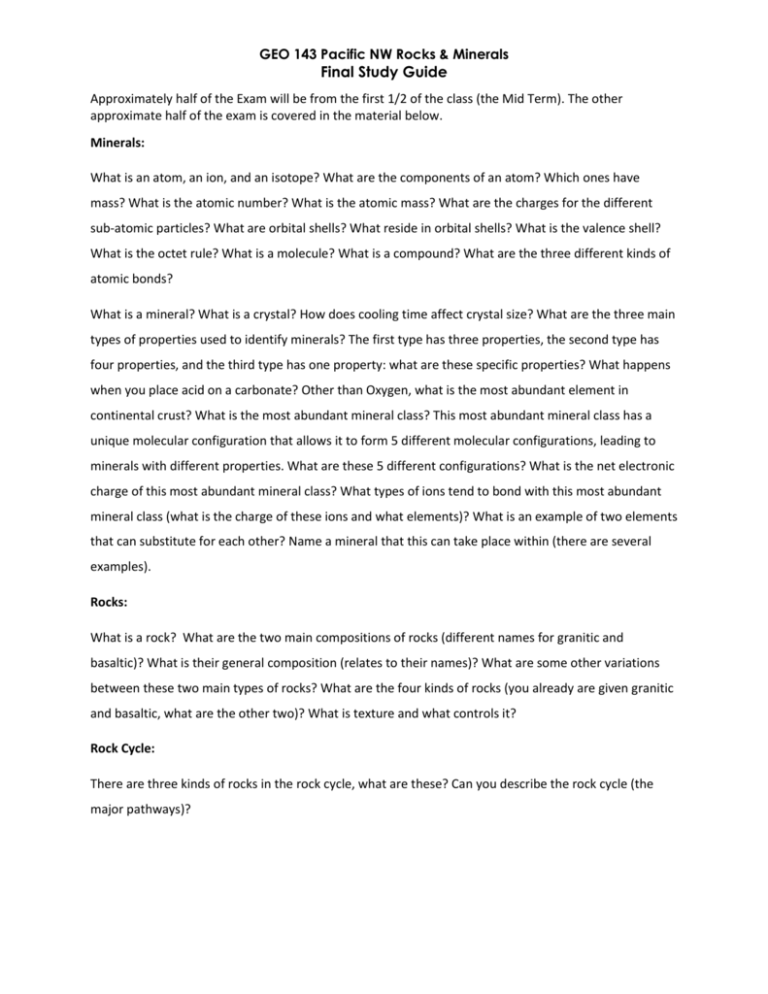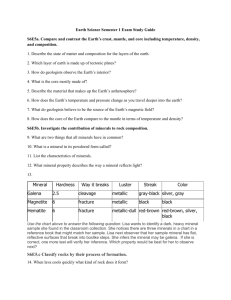GEO143_final_study_g..
advertisement

GEO 143 Pacific NW Rocks & Minerals Final Study Guide Approximately half of the Exam will be from the first 1/2 of the class (the Mid Term). The other approximate half of the exam is covered in the material below. Minerals: What is an atom, an ion, and an isotope? What are the components of an atom? Which ones have mass? What is the atomic number? What is the atomic mass? What are the charges for the different sub-atomic particles? What are orbital shells? What reside in orbital shells? What is the valence shell? What is the octet rule? What is a molecule? What is a compound? What are the three different kinds of atomic bonds? What is a mineral? What is a crystal? How does cooling time affect crystal size? What are the three main types of properties used to identify minerals? The first type has three properties, the second type has four properties, and the third type has one property: what are these specific properties? What happens when you place acid on a carbonate? Other than Oxygen, what is the most abundant element in continental crust? What is the most abundant mineral class? This most abundant mineral class has a unique molecular configuration that allows it to form 5 different molecular configurations, leading to minerals with different properties. What are these 5 different configurations? What is the net electronic charge of this most abundant mineral class? What types of ions tend to bond with this most abundant mineral class (what is the charge of these ions and what elements)? What is an example of two elements that can substitute for each other? Name a mineral that this can take place within (there are several examples). Rocks: What is a rock? What are the two main compositions of rocks (different names for granitic and basaltic)? What is their general composition (relates to their names)? What are some other variations between these two main types of rocks? What are the four kinds of rocks (you already are given granitic and basaltic, what are the other two)? What is texture and what controls it? Rock Cycle: There are three kinds of rocks in the rock cycle, what are these? Can you describe the rock cycle (the major pathways)? GEO 143 Pacific NW Rocks & Minerals Final Study Guide Volcanoes and Volcanic/Plutonic rocks: What controls the viscosity of lava/magma? What controls the shape of volcanoes? What are the different types of volcanoes? Sediments and Sedimentary Rocks: What are the three types of sedimentary rocks? Name some examples of each of these three types of sedimentary rocks. How might the sedimentary rock tell us about the environment it was deposited in? What is particle size? How does this control the type of sedimentary rock? What is sorting? What is rounding (vs. angularity) and what controls rounding (sphericity)? What are the two steps in lithification? What is bedding? What is cross bedding? Metamorphism and Metamorphic Rocks: What are the important agents that drive metamorphism? What is foliation? What is the difference between foliated and non-foliated? Name some foliated rock types. Name some non-foliated rock types. Mt. Saint Helens What types of volcanoes are in the Cascades? What relative Silica content (high, med, or low) are associated with each of these types of volcanoes? Why does the Silica content control the behavior of lava flow? Why does the Silica content control the shape of volcanoes? What type of rock is associated with the different levels of Silica (four types of rock, rank them from low to high Si %)? What is the timeline of events that led to the eruption of Mt. Saint Helens? What happened during and after the eruption of Mt. Saint Helens? How were the different lakes formed around Mt. Saint Helens? Where do we find volcanoes? Why are volcanoes found in these places? What are some volcanoes associated with the Cascadia subduction zone? Which Cascade volcanoes erupt more frequently than others? What are some hazards associated with volcanic eruptions? What controls the type of volcanic eruption, the shape of volcano, and the way that lava flows? Could you identify the following volcanoes: fissure flow, shield volcano, stratovolcano, lava dome, and caldera? Columbia River Basalts What was the geologic event that initiated the eruption of the CRBs? What is the time span for the CRB eruptions? Where is the source of these lava flows? Where did they flow to? What causes columnar jointing? What are the processes that create the stratigraphy of a flood basalt (there are 5 parts, from GEO 143 Pacific NW Rocks & Minerals Final Study Guide bottom to top: pillow basalt, lower colonnade, entablature, upper colonnade, vesicular basalt)? Could you label these parts if you saw a drawing of a flood basalt? Why do we think there are pillow basalts in the CRBs? What is K/Ar age control? What is the basis for this age control method? Radiometric Age Control What is a radioactive half-life? What percent of parent isotopes remain after these different quantities of half-lives: 1, 2, 3, 4, 5, and 6? If the half-life of radiocarbon is 5,730 years, and you determine that there is 12.5% of the parent isotope remaining, how old is the sample? If the half-life of radiocarbon is 5,730 years, and you determine that the sample is 34,380 years old, how much percent of the parent isotope is remaining and how many half-lives have elapsed since the sample was created?







